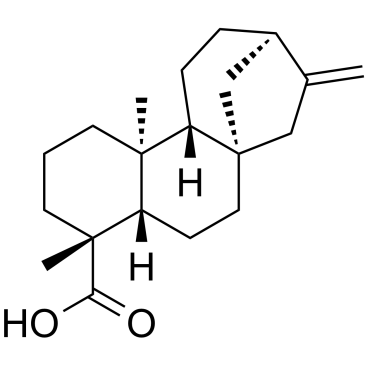Kaurenoic acid

Kaurenoic acid structure
|
Common Name | Kaurenoic acid | ||
|---|---|---|---|---|
| CAS Number | 6730-83-2 | Molecular Weight | 302.451 | |
| Density | 1.1±0.1 g/cm3 | Boiling Point | 426.6±34.0 °C at 760 mmHg | |
| Molecular Formula | C20H30O2 | Melting Point | N/A | |
| MSDS | Chinese USA | Flash Point | 202.8±20.3 °C | |
|
Development and validation of two methods based on high-performance liquid chromatography-tandem mass spectrometry for determining 1,2-benzopyrone, dihydrocoumarin, o-coumaric acid, syringaldehyde and kaurenoic acid in guaco extracts and pharmaceutical preparations.
J. Sep. Sci. 34(7) , 740-8, (2011) In this study, two HPLC-ESI-MS/MS methods were developed and validated for the determination of 1,2-benzopyrone (COU), o-coumaric acid (OCA), kaurenoic acid (KAU), syringaldehyde (SYR), and dihydrocoumarin (DIH) in guaco extracts and pharmaceutical preparatio... |
|
|
Anticonvulsant effect of kaurenoic acid isolated from the root bark of Annona senegalensis.
Pharmacol. Biochem. Behav. 109 , 38-43, (2013) The herbal preparations of Annona senegalensis Pers. (Annonaceae) root bark are used in Nigerian ethnomedicine for the treatment of epilepsy and febrile seizures. The scientific evidence for this effect has been reported.The aim of this study was to identify ... |
|
|
Biosynthesis of uterotonic diterpenes from Montanoa tomentosa (zoapatle).
J. Plant Physiol. 166(18) , 1961-7, (2009) Montanoa tomentosa (zoapatle) is a Central American plant used in Mexico in traditional herbal medicine to ease childbirth labor and to cure certain female disorders. Recently, crude extracts of M. tomentosa have been reported to have an aphrodisiacal effect ... |
|
|
Isolation of two bioactive diterpenic acids from Copaifera glycycarpa oleoresin by high-speed counter-current chromatography.
Phytochem. Anal. 21(6) , 539-43, (2010) Phytochemical and biological studies carried out on Copaifera species showed that their oleoresins and isolated compounds have various biological activities.The aims of this work were (i) to analyse the Copaifera oleoresin by gas chromatography-mass spectrome... |
|
|
Hypoglycaemic effects of tea extracts and ent-kaurenoic acid from Smallanthus sonchifolius.
Nat. Prod. Res. 24(18) , 1771-82, (2010) Hypoglycaemic activity was observed in normoglycaemic mice orally administered with the aqueous Smallanthus sonchifolius leaf tea extract, alloxan-induced diabetic mice orally administered with ent-kaurenoic acid (1), and normoglycaemic mice intraperitoneally... |
|
|
iso-Kaurenoic acid from Wedelia paludosa D.C.
An. Acad. Bras. Ciênc. 82(4) , 823-31, (2010) A recent reinvestigation of aerial parts of Wedelia paludosa D.C. is described and reports, for the first time, the isolation of iso-kaurenoic acid from this species. |
|
|
An ent-kaurane-type diterpene in Croton antisyphiliticus mart.
Molecules 17(8) , 8851-8, (2012) Croton antisyphiliticus is a medicinal plant widely used in the treatment of microbial infections, especially those affecting the genital tract. Crude extract, fractions and pure compound isolated from roots of this species were investigated to validate their... |
|
|
On the isomerization of ent-kaurenic acid.
Nat. Prod. Commun. 6(7) , 935-8, (2011) Kaurenic acid (1a) is a tetracyclic diterpene that has an exocyclic double bond at delta16. Isokaurenic acid (2a) has an endocyclic delta15double bond. This compound has been isolated from Espeletia tenore (Espeletinae), a resinous plant from the Venezuelan A... |
|
|
Cytotoxic effect of some natural compounds isolated from Lauraceae plants and synthetic derivatives.
Biomedica. 31(3) , 335-43, (2011) The antiproliferative effect of eleven neolignans, two lignans and one diterpene isolated from three Lauraceae plants, four benzofurans and two bicyclooctanes synthetic derivatives was evaluated in vitro on a set of five human cancer cells from solid tumors w... |
|
|
The epimer of kaurenoic acid from Croton antisyphiliticus is cytotoxic toward B-16 and HeLa tumor cells through apoptosis induction.
Genet. Mol. Res. 12(2) , 1005-11, (2013) Cancer has become the leading cause of death in developing countries due to increased life expectancy of the population and changes in lifestyle. Studies on active principles of plant have motivated researchers to develop new antitumor agents that are specifi... |